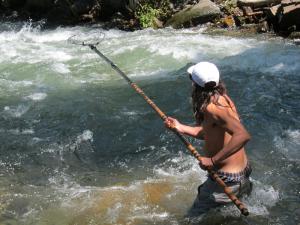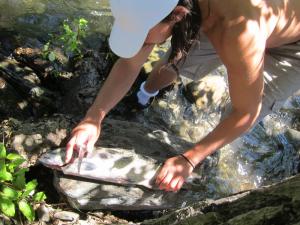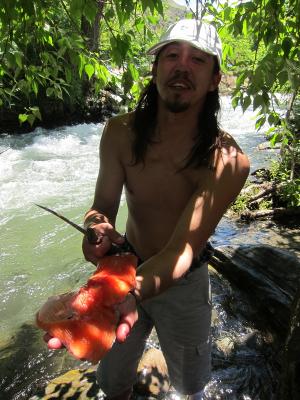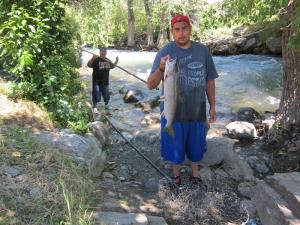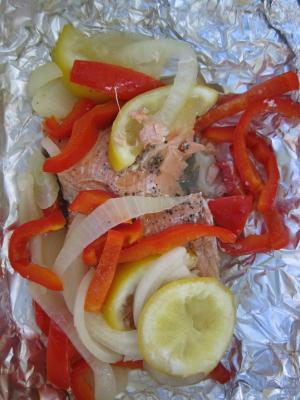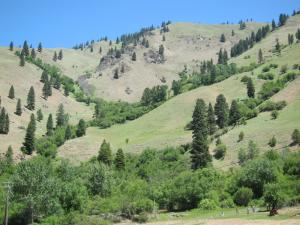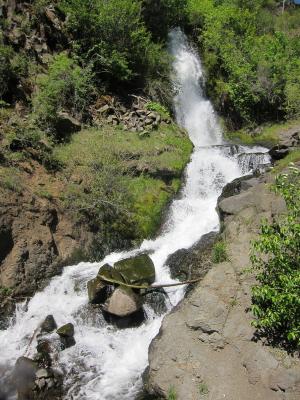SEA TO SHINING SEA: Salmon fishing with the Nez Perce
DAY 23 - Smelling fresh logs across America. The logging trucks pass us at about 65 miles an hour, four or five feet away. We can smell the fresh-cut logs when the trucks pass. The livestock trucks also pass with a distinctive odor. Logs and beef. Those are the mainstays of the Pacific northwest.
Today we logged 36 miles, almost all downhill. Averaged 13.2 mph with 672 feet of ascent. Council to Riggins. Pretty good shoulder all the way.
Riggins touts itself as the whitewater capital of Idaho. The Rapid River and Little Salmon River roll together somewhere south of here and join the mighty Salmon River. Jim, here at River Village Park where we're camped for the night, tells us that the Salmon is the longest undammed river in North America.
"It's a real gem. And the salmon and the steelhead trout have come back nicely. All the dams on the Columbia really hurt those populations. But over the years, with lots of fish hatchery activity and fish ladders to allow the salmon to get past the dams, the fish are coming back."
But Jim's not real happy today. This is the time of year when his park fills with fishermen in the hunt for spawning fish. "But they shut the fishery down completely a week or so ago. You wouldn't have a place to pitch your tent tonight if they hadn't done that. This high bank along the Salmon would be crowded with anglers. I've had all kinds of cancellations. It's really hurt me and the whole town. I don't know why they couldn't have cut the limit down to just one fish. Even at that the peopler would still come. But shutting it down completely? It doesn't make any sense. I guess they figured the catch so far was too much to be sustainable."
The closure didn't affect the members of the Nez Perce tribe that we passed a few miles south of town. Fishing a section of the Rapid River reserved only for their tribe, they stood waist deep in the rushing river with big dip nets attached to the end of wooden poles fifteen to twenty feet long. They stabbed the nets upriver from where they stood and guided their descent through the deep and narrow hole in that special section of the river. Feeling along the bottom, they would scoop through a fish. It requires a deft touch given the power and motion of the river. Sam told Becky that one member of the tribe drowned this time last year when he scooped a big fish - or maybe two - lost his balance and was swept away by the strong current.
"We call this the gravy hole because we catch so many Chinook salmon and steelheads here," said Virgil.
'It's our birthright," said Sam, proud of his Nez Perce heritage. "There are about 3,000 of us remaining. 300 pure bloods. I'm one of the pure bloods."
"Do you have pure blood children?" I asked.
"I do," said Sam. "At one time we were the dominant tribe throughout this area. Best at fishing. Best on the buffalo grounds."
Sam and Virgil said members of the tribe fish this section of the Rapid River throughout the spawning season which lasts through May and June. There's a fish hatchery a ways up the river and the fish released there - the ones that survive - come back this way every year in the late spring. A small fin just in front of the hatchery fish tails - the adipose fin - gets clipped before the fish are released. They're the only fish that anglers - except for the Nez Perce - can keep. The Native Americans can keep whatever they catch. Their catch is an important food source for them and their families as well as a source of cash.
We bought a Chinook from Lonnie who fileted it for us by the river. Two great big pink filets. Becky gave one to a lady who lives here in the park. She packaged the others in tin foil after shingling them with thick layers of yellow onions, red peppers and sliced lemons. We steamed them over a campfire here by the Salmon. Needless to say they were excellent and went down sweetly with cold Chardonnay.
Astros are shellacking the Birds as I finish this blog. Bottom of the fifth and the Houston team is up 9-1.
Big ride tomorrow. A stretch of downhill for 20 or so miles before we turn upward to go over a 2,200 foot ascent. Headed for Grangerville, home of the nation's first Grange organization. Stockmen and farmers.
Missoula, Montana is about 220 miles away. Stay tuned. Thanks for traveling with us.
|
Follow our cross-country bicycle journey on Facebook by liking Sea to Shining Sea » |
||||















